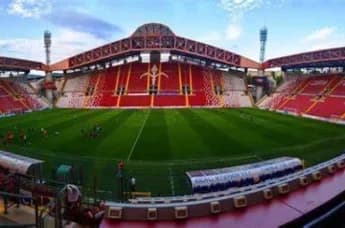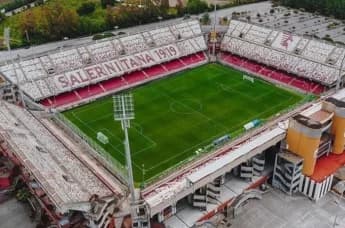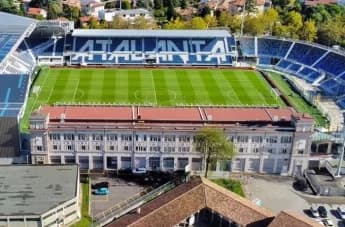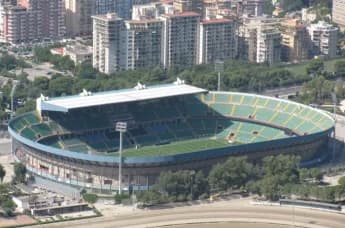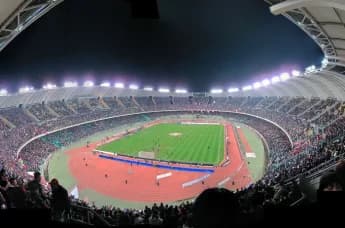The San Siro, a symbol of sporting excellence, has been the backdrop for countless legendary moments in football, attracting fans and players to its storied grounds.
The San Siro, officially known as Stadio Giuseppe Meazza, is not just a football stadium; it represents a global emblem of sporting excellence and a pivotal element of football history. Located in the San Siro district of Milan, Italy, this iconic venue is a testament to the city's devotion to the beautiful game. With a capacity to seat 80,018 spectators, it is the largest stadium in Italy and ranks among the most renowned in the world. It serves as a joint home for two footballing giants, AC Milan and Inter Milan, whose fierce rivalry is one of the most passionate and historic in the sport. For nearly a century, the San Siro has stood as a sacred ground where legends are forged, rivalries erupt, and history is created.
This magnificent stadium stands as more than just a local gem; it is a symbol of football culture on a global scale. Its striking architecture, famous for its distinctive design and towering red support beams, commands attention on the Milan skyline, attracting both fans and tourists. From the thundering cheers of the crowd during Serie A games to the vibrant atmosphere of international competitions, the San Siro embodies the essence of football in its truest form.
Designated as a UEFA Category Four stadium, the San Siro has been the venue for numerous prestigious events in the annals of football. It has served as the backdrop for memorable UEFA Champions League finals, FIFA World Cup matches, and other significant tournaments, reinforcing its reputation as a place that creates unforgettable moments. For fans, experiencing a match at the San Siro is a must-do. Its bowl-like architecture provides excellent visibility from every seat, while its acoustics enhance the crowd's roars and cheers, producing a sound that echoes throughout the stands.
The San Siro stands as a testament to Milan's heritage and identity, surpassing its mere physical presence. It embodies the city’s vibrant cultural landscape and serves as a communal hub for fans across generations, all connected by their passion for football. Be it the intense Derby della Madonnina, where AC Milan and Inter Milan vie for dominance, or an exhilarating international match, the stadium transforms into a whirlwind of emotions, vividly illustrating the fervor and pride of its supporters.
The San Siro is more than just a football stadium; it stands as a monument to the sport itself. It has seen innumerable moments of glory and despair, serving as a treasure trove of memories for millions of fans around the globe. Its importance goes beyond national boundaries, transforming it into a pilgrimage destination for football lovers who journey to Milan to soak in its enchantment. As it adapts and evolves to meet the needs of contemporary football, the San Siro remains a lasting emblem of the sport's timeless appeal, securing its legacy as one of the most esteemed stadiums worldwide.
Legendary Matches
The San Siro has served as the backdrop for numerous iconic matches, firmly establishing its legacy in the annals of football history. Its revered pitch has hosted unforgettable events that have significantly influenced the sport, transforming it into a temple for both fans and players.
One of the stadium’s earliest legendary moments occurred during the 1934 FIFA World Cup when it hosted three matches, including a thrilling semi-final between Italy and Austria. This event marked the beginning of the San Siro’s rise to prominence on the international stage. Years later, the stadium gained even more recognition by hosting six matches during the 1990 FIFA World Cup, which included the exciting opening ceremony and group-stage games that fascinated millions of fans around the globe.
The UEFA Champions League finals have significantly contributed to the San Siro's reputation, as it has been the backdrop for some of the most thrilling nights in European football. In 1965, Inter Milan celebrated a victory on their home ground, a moment forever cherished by Nerazzurri fans. The 2016 Champions League final, featuring Real Madrid and Atlético Madrid, was another landmark occasion, highlighted by an intense penalty shootout, further establishing the stadium as a stage for the sport’s most extraordinary events.
In Italy, the Derby della Madonnina, which embodies the intense rivalry between AC Milan and Inter Milan, has given rise to numerous unforgettable contests. These electrifying encounters have produced stunning goals, intense moments, and a celebration of fervor that only the passionate fans of Milan can bring. Historic matches like AC Milan's overwhelming 6–0 victory in 2001 and Inter's significant 4–0 win in 2009 are firmly embedded in the history of football.
The San Siro has hosted a variety of international matches as well. Notable moments include Italy's 2-1 victory over Ukraine in the Euro 2024 qualifiers and the 3-1 win against England in the UEFA Nations League. These games, filled with intensity and emotion, highlight the stadium’s standing as a stronghold for exhilarating football events.
Amenities and Features
The San Siro's architectural splendor and amenities designed for fans distinguish it as one of the top stadiums globally. Its distinctive design includes a bowl-shaped configuration and impressive helical ramps, allowing for easy access to the upper levels while providing exceptional views of the pitch from every seat. The notable red girders that uphold the roof contribute a unique visual appeal, making the stadium instantly identifiable around the globe.
The stadium features an impressive seating capacity of 80,018, guaranteeing an exhilarating atmosphere during matches. Its acoustics enhance the fans' cheers, producing an electrifying environment that is truly unparalleled. The San Siro also provides fans with modern amenities, including roomy seating areas, top-notch restrooms, and various food and beverage outlets that cater to a wide range of preferences.
A notable highlight of the stadium is its museum, which was opened in 1996. This museum acts as a tribute to the rich histories of AC Milan and Inter Milan, featuring an impressive array of historical jerseys, trophies, memorabilia, and artworks. Guests have the opportunity to delve into the remarkable stories of these two footballing powerhouses, exploring their successes and the iconic players who contributed to their legendary status.
Furthermore, the San Siro offers VIP hospitality options, featuring opulent lounges and exclusive boxes that provide exceptional views and unique experiences. These areas are outfitted with cutting-edge amenities, making them perfect for corporate gatherings or premium fan experiences.
The stadium places a strong emphasis on accessibility, featuring specialized facilities for fans with disabilities to ensure that everyone can experience the excitement of matchday. Additionally, family-friendly areas are available, providing a secure and enjoyable setting for those attending with children.
Technological advancements significantly enhance the experience for fans at the San Siro. The venue features high-definition LED screens and a sophisticated sound system, ensuring that every replay and announcement is communicated clearly, keeping the audience engaged throughout the event. Additionally, the stadium is equipped with ample parking and efficient public transport links, making it easy to access for both local visitors and those traveling from abroad.
The San Siro fuses tradition with contemporary elements, ensuring it satisfies the desires of modern football enthusiasts while paying homage to its rich history. More than just a stadium, it stands as a symbol of football's lasting charm and serves as a guiding light for supporters globally.
Significance in History
The history of the San Siro is deeply connected to the development of football itself. The concept for the stadium emerged in the early 1920s, when Piero Pirelli, the president of AC Milan, envisioned a modern facility dedicated entirely to the sport. The site, located in the San Siro district near a horse racing track, was selected due to its ample space and accessibility. Officially opened on September 19, 1926, the stadium staged its inaugural match, a thrilling derby in which Inter Milan triumphed over AC Milan with a score of 6–3. Although it was a relatively simple design at the time, its promise was unmistakable.
Originally owned by AC Milan, the stadium became a joint venue in 1947 when Inter Milan relocated from the Arena Civica. This collaboration signified the start of a lasting bond between the two prominent football clubs in the city, transforming the San Siro into an emblem of both competition and camaraderie. Throughout the years, the stadium has seen several renovations aimed at increasing its capacity and updating its amenities. Among the most significant enhancements took place between 1948 and 1955, when engineers Armando Ronca and Ferruccio Calzolari crafted a proposal to raise capacity to 150,000 spectators. Although the final design could accommodate 100,000 due to structural constraints, this initiative positioned the San Siro as a venue capable of hosting large audiences.
In 1980, the stadium was renamed Stadio Giuseppe Meazza in tribute to one of Italy's legendary football players. Giuseppe Meazza, a two-time World Cup champion, represented both Inter and Milan, although he is primarily remembered for his time with Inter. Even after the official renaming, fans from both AC Milan and Inter Milan often refer to the stadium simply as San Siro, highlighting its enduring connection to the neighborhood and its cultural significance.
The importance of San Siro goes beyond just club football. It has been the venue for significant matches in international competitions, including the FIFA World Cups of 1934 and 1990, along with UEFA Euro 1980. Renovations carried out in preparation for the 1990 World Cup drastically changed the stadium, adding a third tier and its iconic red roof girders. This era ushered in a new phase for the stadium, blending innovative design with its historical allure.
The establishment of an on-site museum in 1996 solidified the San Siro’s identity as a pilgrimage destination for football enthusiasts. Guests have the opportunity to delve into the rich legacies of AC Milan and Inter, admire various trophies, and engage with the narratives of iconic players. Today, the San Siro continues to play an essential role in football's heritage, serving as a connection between the sport's history, present, and future.
Future Events
The future of San Siro shines brightly, reflecting its remarkable history. The stadium is set to play a crucial role in the 2026 Winter Olympics, where it will host the opening ceremony, highlighting its versatility beyond the realm of football. Furthermore, it is a leading candidate to host matches during the UEFA Euro 2032, likely bringing football fans from all over Europe together once more. With a calendar filled with domestic matches, international friendlies, and intense club rivalries each year, San Siro continues to be a center of sporting excellence and cultural significance.
Experience for Fans
For fans, visiting the San Siro is a truly enchanting experience. The adventure begins with the breathtaking view of its impressive facade, featuring striking red girders and winding ramps. Once inside, the ambiance is charged with energy, as enthusiastic supporters chant and wave flags in harmony. The hallways are filled with food stands offering delightful Italian dishes, from pizzas to gelato, ensuring that fans are satisfied and invigorated. The on-site museum provides an insightful look into the rich history of Milanese football, making for an excellent pre-match activity. With cozy seating, effective crowd control, and a spirit of togetherness that rises above rivalries, attending a match or event at San Siro is a memorable occasion that every football lover should treasure.



